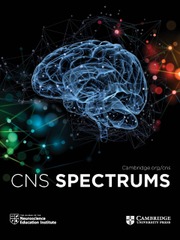Crossref Citations
This article has been cited by the following publications. This list is generated based on data provided by
Crossref.
Tordesillas-Gutierrez, Diana
Koutsouleris, Nikolaos
Roiz-Santiañez, Roberto
Meisenzahl, Eva
Ayesa-Arriola, Rosa
Marco de Lucas, Enrique
Soriano-Mas, Carles
Suarez-Pinilla, Paula
and
Crespo-Facorro, Benedicto
2015.
Grey matter volume differences in non-affective psychosis and the effects of age of onset on grey matter volumes: A voxelwise study.
Schizophrenia Research,
Vol. 164,
Issue. 1-3,
p.
74.
Ordóñez, Anna E.
Sastry, Nevin V.
and
Gogtay, Nitin
2015.
Functional and clinical insights from neuroimaging studies in childhood-onset schizophrenia.
CNS Spectrums,
Vol. 20,
Issue. 4,
p.
442.
Nenadic, Igor
Yotter, Rachel A.
Sauer, Heinrich
and
Gaser, Christian
2015.
Patterns of cortical thinning in different subgroups of
schizophrenia.
British Journal of Psychiatry,
Vol. 206,
Issue. 6,
p.
479.
Czepielewski, Letícia Sanguinetti
Wang, Lei
Gama, Clarissa S.
and
Barch, Deanna M.
2016.
The Relationship of Intellectual Functioning and Cognitive Performance to Brain Structure in Schizophrenia.
Schizophrenia Bulletin,
p.
sbw090.
Shin, Jean
French, Leon
Xu, Ting
Leonard, Gabriel
Perron, Michel
Pike, G Bruce
Richer, Louis
Veillette, Suzanne
Pausova, Zdenka
and
Paus, Tomáš
2018.
Cell-Specific Gene-Expression Profiles and Cortical Thickness in the Human Brain.
Cerebral Cortex,
Vol. 28,
Issue. 9,
p.
3267.
Seitz, Johanna
Rathi, Yogesh
Lyall, Amanda
Pasternak, Ofer
del Re, Elisabetta C.
Niznikiewicz, Margaret
Nestor, Paul
Seidman, Larry J.
Petryshen, Tracey L.
Mesholam-Gately, Raquelle I.
Wojcik, Joanne
McCarley, Robert W.
Shenton, Martha E.
Koerte, Inga K.
and
Kubicki, Marek
2018.
Alteration of gray matter microstructure in schizophrenia.
Brain Imaging and Behavior,
Vol. 12,
Issue. 1,
p.
54.
McKenna, Faye F.
Miles, Laura
Babb, James S.
Goff, Donald C.
and
Lazar, Mariana
2019.
Diffusion kurtosis imaging of gray matter in schizophrenia.
Cortex,
Vol. 121,
Issue. ,
p.
201.
Tahedl, Marlene
2020.
Towards individualized cortical thickness assessment for clinical routine.
Journal of Translational Medicine,
Vol. 18,
Issue. 1,
Alkan, Erkan
Davies, Geoff
and
Evans, Simon L.
2021.
Cognitive impairment in schizophrenia: relationships with cortical thickness in fronto-temporal regions, and dissociability from symptom severity.
npj Schizophrenia,
Vol. 7,
Issue. 1,
Rosa, Pedro Gomes Penteado
Zugman, Andre
Cerqueira, Carlos Toledo
Serpa, Mauricio Henriques
de Souza Duran, Fabio Luis
Zanetti, Marcus Vinicius
Bassitt, Débora Pastore
Elkis, Helio
Crippa, José Alexandre S.
Sallet, Paulo Clemente
Gattaz, Wagner Farid
Hallak, Jaime Eduardo Cecilio
Louzã, Mario Rodrigues
Gadelha, Ary
Jackowski, Andrea Parolin
Bressan, Rodrigo Affonseca
and
Filho, Geraldo Busatto
2021.
Cortical surface abnormalities are different depending on the stage of schizophrenia: A cross-sectional vertexwise mega-analysis of thickness, area and gyrification.
Schizophrenia Research,
Vol. 236,
Issue. ,
p.
104.
Busatto Filho, Geraldo
Rosa, Pedro G.
Serpa, Mauricio H.
Squarzoni, Paula
and
Duran, Fabio L.
2021.
Psychiatric neuroimaging research in Brazil: historical overview, current challenges, and future opportunities.
Brazilian Journal of Psychiatry,
Vol. 43,
Issue. 1,
p.
83.
Thielen, J.-W.
Müller, B. W.
Chang, D.-I.
Krug, A.
Mehl, S.
Rapp, A.
Walter, H.
Winterer, G.
Vogeley, K.
Klingberg, S.
Wagner, M.
and
Kircher, T.
2022.
Cortical thickness across the cingulate gyrus in schizophrenia and its association to illness duration and memory performance.
European Archives of Psychiatry and Clinical Neuroscience,
Vol. 272,
Issue. 7,
p.
1241.
O'Connell, Kevin S.
Sønderby, Ida E.
Frei, Oleksandr
van der Meer, Dennis
Athanasiu, Lavinia
Smeland, Olav B.
Alnæs, Dag
Kaufmann, Tobias
Westlye, Lars T.
Steen, Vidar M.
Andreassen, Ole A.
Hughes, Timothy
and
Djurovic, Srdjan
2022.
Association between complement component 4A expression, cognitive performance and brain imaging measures in UK Biobank.
Psychological Medicine,
Vol. 52,
Issue. 15,
p.
3497.
Langenbach, Benedikt P.
Kohl, Waldemar
Murai, Toshiya
Suslow, Thomas
Ohrmann, Patricia
Bauer, Jochen
Matsukawa, Noriko
Son, Shuraku
Pedersen, Anya
Lichtenstein, Theresa
Miyata, Jun
and
Koelkebeck, Katja
2022.
Cortical changes in patients with schizophrenia across two ethnic backgrounds.
Scientific Reports,
Vol. 12,
Issue. 1,
Panikratova, Ya. R.
Tomyshev, A. S.
Abdullina, E. G.
Tikhonov, D. V.
Alekseeva, A. G.
Kaleda, V. G.
Strelets, V. B.
and
Lebedeva, I. S.
2024.
Structural and Functional Characteristics of the Dorsolateral Prefrontal Cortex in Schizophrenia Spectrum Disorders and Their Associations with Onset Age.
Psikhiatriya,
Vol. 22,
Issue. 2,
p.
6.
Kazinka, Rebecca
Choi, Da Som
Opitz, Alexander
and
Lim, Kelvin O.
2024.
Individuals with psychosis receive less electric field strength during transcranial direct current stimulation compared to healthy controls.
Schizophrenia,
Vol. 10,
Issue. 1,
Wu, Yao-Cheng
Huang, Chih-Chung
Wang, Yi-Guang
Yang, Chu-Ya
Chang, Wei-Chou
Chang, Chuan-Chia
and
Chang, Hsin-An
2025.
Frontal and Parietal Alpha Asymmetry as Biomarkers for Negative Symptoms in Schizophrenia.
Psychiatry Investigation,
Vol. 22,
Issue. 4,
p.
435.
Lin, Chien-Ho (Janice)
Hsueh, Hsueh-Wen
Chiang, Ming-Chang
Hsieh, Sung-Tsang
and
Chao, Chi-Chao
2025.
Cortical reorganization in neuropathic pain due to peripheral nerve degeneration: altered cortical surface morphometry and hierarchical topography.
Pain,
Vol. 166,
Issue. 9,
p.
2128.

